Hadhramaut
Hadhramaut[lower-alpha 1] (Arabic: حَضْرَمَوْتُ \ حَضْرَمُوتُ, romanized: Ḥaḍramawt / Ḥaḍramūt; Hadramautic: 𐩢𐩳𐩧𐩣𐩩, Ḥḍrmt) is a region in southern Arabia. The name is of ancient origin, and is retained in the name of the Hadhramaut Governorate of Yemen. The people of Hadhramaut are called Hadhrami. They formerly spoke Hadramautic, but now predominantly speak Hadhrami Arabic.
Hadhramaut حَضْرَمَوْتُ حَضْرَمُوتُ Ḥaḍramawt Ḥaḍramūt | |
|---|---|
.jpg) Above: Buildings at the base of mountains in Wadi Hadhramaut
| |
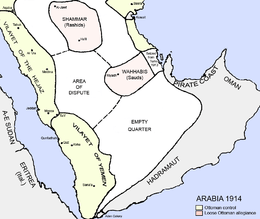 |
Etymology
The origin of the name "Ḥaḍramawt" is not exactly known, and there are numerous competing hypotheses about its meaning. The most common folk etymology is that the region's name means "death has come," from Arabic: حَضَر, romanized: ḥaḍara, lit. 'he came' and Arabic: مَوْت, romanized: mawt, lit. 'death', though there are multiple explanations for how it came to be known as such. One explanation is that this is a nickname of 'Amar ibn Qaḥṭān, a legendary invader of the region, whose battles always left many dead. Another theory is that after the destruction of Thamūd, the Islamic prophet Ṣāliḥ relocated himself and about 4,000 of his followers to the region and it was there that he died, thus lending the region its morbid name "death has come." A third related etymology posits that حضر refers to the inhabitants of the area, themselves, and hints that the way of life of the ancient Hadhrami people was severe and ascetic in the eyes of the bordering kingdoms situated in today's North Yemen.
Ḥaḍramawt is also identified with Biblical Hazarmawet (Biblical Hebrew: חֲצַרְמָוֶת; Genesis 10:26[1] and 1 Chronicles 1:20).[2] There, it is the name of a son of Joktan (who is also identified with Qahtan), the ancestor of the South Arabian kingdoms. According to various Bible dictionaries, the name "Hazarmaveth" means "court of death," reflecting a meaning similar to the Arabic folk etymologies.
Scholarly theories of the name's origin are somewhat more varied, but none have gained general acceptance. Juris Zarins, rediscoverer of the city claimed to be the ancient Incense Route trade capital Ubar in Oman, suggested that the name may come from the Greek word ὕδρευματα hydreumata, or enclosed (and often fortified) watering stations at wadis. In a Nova interview,[3] he described Ubar as:
a kind of fortress/administration center set up to protect the water supply from raiding Bedouin tribes. Surrounding the site, as far as six miles away, were smaller villages, which served as small-scale encampments for the caravans. An interesting parallel to this are the fortified water holes in the Eastern Desert of Egypt from Roman times. There, they were called hydreumata.
Though it accurately describes the configuration of settlements in the pre-7th century Wadi Ḥaḍramawt, this explanation for the name is anachronistic and has gained no wider scholarly acceptance. Already in the period before the advent of Islam in the 7th century CE, variations of the name are attested as early as the middle of the First Millennium BC. The names ḥḍrmt (𐩢𐩳𐩧𐩣𐩩) and ḥḍrmwt (𐩢𐩳𐩧𐩣𐩥𐩩) are found in texts of the Old South Arabian languages (Ḥaḍramitic, Minaic, Qatabanic, and Sabaean), though the second form is not found in any known Ḥaḍramitic inscriptions.[4] In either form, the word itself can be a toponym, a tribal name, or the name of the kingdom of Ḥaḍramawt. In the late fourth or early third century BC, Theophrastus gives the name Άδρραμύτα,[5] a direct transcription of the Semitic name into Greek.
As Southern Arabia is the homeland of the South Semitic language subfamily, a Semitic origin for the name is highly likely. Kamal Salibi proposed an alternative etymology for the name which argues that the diphthong "aw" in the name is an incorrect vocalization.[6] He notes that "-ūt" is a frequent ending for place names in the Ḥaḍramawt, and given that "Ḥaḍramūt" is the colloquial pronunciation of the name, and apparently also its ancient pronunciation, the correct reading of the name should be "place of ḥḍrm." He proposes, then, that the name means "the green place," which is apt for its well-watered wadis whose lushness contrasts with the surrounding high desert plateau.
Geography and geology
Narrowly, Hadhramaut refers to the historical Qu'aiti and Kathiri sultanates , which were in the Aden Protectorate overseen by the British Resident at Aden until their abolition upon the independence of South Yemen in 1967. The current governorate of Hadhramaut roughly incorporates the former territory of the two sultanates It consists of a narrow, arid coastal plain bounded by the steep escarpment of a broad plateau (Arabic: ٱلْجَوْل, romanized: al-Jawl, averaging 1,370 m (4,490 ft)), with a very sparse network of deeply sunk wadis (seasonal watercourses). The undefined northern edge of Hadhramaut slopes down to the desert Empty Quarter. Where the Hadhramaut Plateau or Highlands (Arabic: هَضْبَة حَضْرَمَوْت, romanized: Haḍbat Ḥaḍramawt) meets the Gulf of Aden in the Arabian Sea, elevation abruptly decreases.[7]
In a wider sense, Hadhramaut includes the territory of Mahra to the east all the way to the contemporary border with Oman.[8] This encompasses the current governorates of Hadramaut and Mahra in their entirety as well as parts of the Shabwah Governorate.
The Hadhramis live in densely built towns centered on traditional watering stations along the wadis. Hadhramis harvest crops of wheat and millet, tend date palm and coconut groves, and grow some coffee. On the plateau, Bedouins tend sheep and goats. Society is still highly tribal, with the old Seyyid aristocracy, descended from the Islamic prophet Muhammad, traditionally educated, strict in their Islamic observance, and highly respected in religious and secular affairs.
Mountains
| Hadhramaut Mountains | |
|---|---|
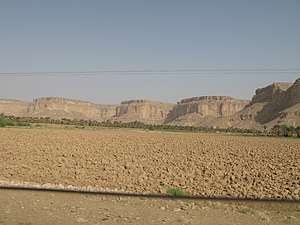 Wadi Hadhramaut | |
| Highest point | |
| Coordinates | 15.3°N 50.7°E |
| Naming | |
| Native name | جِبَال حَضْرَمَوْت (Arabic) |
| Geography | |
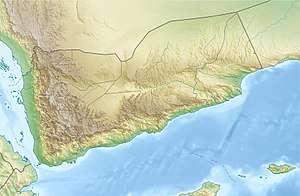 Hadhramaut Mountains 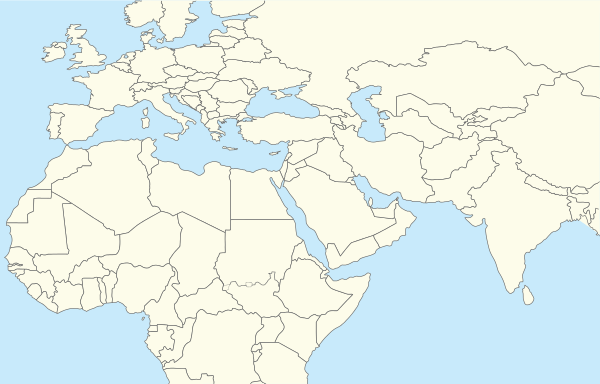 Hadhramaut Mountains 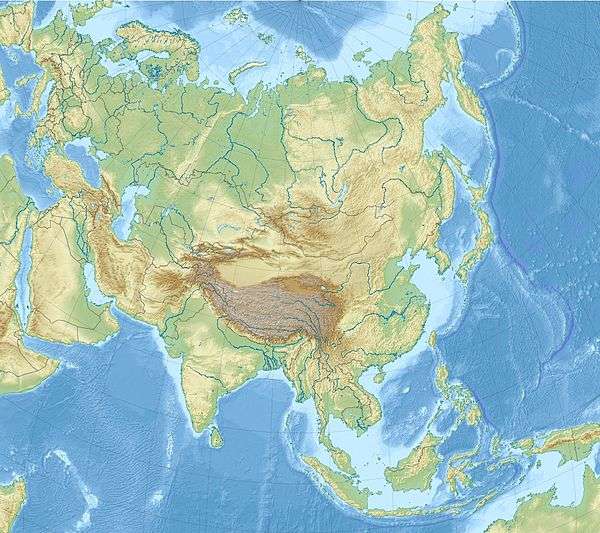 Hadhramaut Mountains | |
| Country | |
| State/Province | Asia |
The Hadhramaut Mountains (Arabic: جِبَال حَضْرَمَوْت, romanized: Jibāl Ḥaḍramawt)[9] are a mountain range in Yemen.[10] They are contiguous with the Omani Dhofar Mountains to the northeast,[7] and James Canton considered Aden in the southwest to be in the mountains' recesses.[11]
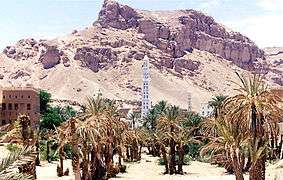 The city of Tarim
The city of Tarim Hajjarin in Wadi Dawan
Hajjarin in Wadi Dawan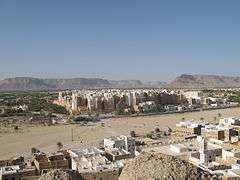 Shibam in Wadi Hadhramaut, with mountains in the background
Shibam in Wadi Hadhramaut, with mountains in the background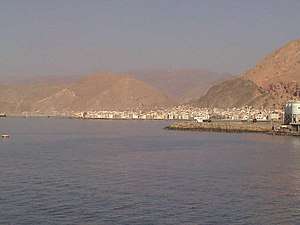
History
Ancient
The Hadhrami are referred to as Chatramotitai in ancient Greek texts. Hadhramautic texts come later than Sabaean ones, and some Sabaean texts from Hadhramaut are known.[12]
Greek, Latin, Sabaean and Hadhramautic texts preserve the names of a large number of kings of Hadhramaut, but there is as yet no definitive chronology of their reigns. Their capital was Shabwa in the northwest corner of the kingdom, along the Incense Route. Eratosthenes called it a metropolis. It was an important cult centre as well. At first the religion was South Arabian polytheism, distinguished by the worship of the Babylonian moon god Sin. By the sixth century the monotheistic cult of Raḥmān was followed in the local temple.[12]
The political history of Hadhramaut is not easy to piece together. Numerous wars involving Hadhramaut are referenced in Sabaean texts. From their own inscriptions, the Hadhrami are known to have fortified Libna (modern-day Qalat)[13] against Himyar and to have fortified Mwyt (Ḥiṣn al-Ghurāb) against the Aksumites in the period following the death of Dhū Nuwās (525/7).[12]
The kingdom ceased to exist by the end of the third century AD, having been annexed by the Himyarite Kingdom. Hadhramaut continued to be used in the full titulature of the kings of Sabaʾ and Dhu Raydān (Himyar).[12]
Early Islamic authors believed the nomadic Kinda tribe that founded a kingdom in central Arabia were originally from Hadhramaut, although distinct from the settled Hadhrami population.[12]
Modern
The Qu'aiti sultans ruled the vast majority of Hadramaut, under a loose British protectorate, the Aden Protectorate, from 1882 to 1967, when the Hadhramaut was annexed by South Yemen. The Qu'aiti dynasty was founded by 'Umar bin Awadh al-Qu’aiti, a Yafa’i tribesman whose wealth and influence as hereditary Jemadar of the Nizam of Hyderabad's armed forces enabled him to establish the Qu'aiti dynasty in the latter half of the 19th century, winning British recognition of his paramount status in the region, in 1882. The British Government and the traditional and scholarly sultan Ali bin Salah signed a treaty in 1937 appointing the British government as "advisors" in Hadhramaut. The British exiled him to Aden in 1945, but the Protectorate lasted until 1967.
In 1967, the former British Colony of Aden and the former Aden Protectorate including Hadramaut became an independent Communist state, the People's Republic of South Yemen, later the People's Democratic Republic of Yemen. South Yemen was united with North Yemen in 1990 as the Republic of Yemen. See History of Yemen for recent history.
The capital and largest city of Hadhramaut is the port Mukalla. Mukalla had a 1994 population of 122,400 and a 2003 population of 174,700, while the port city of Ash Shihr has grown from 48,600 to 69,400 in the same time. One of the more historically important cities in the region is Tarim. An important locus of Islamic learning, it is estimated to contain the highest concentration of descendants of the Prophet Muhammad anywhere in the world.[14]
Economy
Historically, Hadhramaut was known for being a major producer of frankincense, which was mainly exported to Mumbai in the early 20th century.[15] The region has also produced senna and coconut. Currently, Hadhramout produces approximately 260,000 barrels of oil per day; one of the most productive fields is Al Maseelah in the strip (14), which was discovered in 1993. The Yemeni government is keen to develop its oil fields to increase oil production in order to increase national wealth in response to the requirements of economic and social development in the country. Oil contributes 30-40% of the nation's GDP, over 70% of total state revenues, and more than 90% of the value of the country's exports.[16]
Hadhrami diaspora
Since the early 19th century, large-scale Hadhramaut migration has established sizable Hadhrami minorities all around the Indian Ocean,[17] in South Asia, Southeast Asia and East Africa including Hyderabad, Aurangabad,[18][19] Bhatkal, Gangolli, Malabar, Sylhet, Malay Archipelago, Sri Lanka, southern Philippines and Singapore. In Hyderabad and Aurangabad, the community is known as Chaush and resides mostly in the neighborhood of Barkas. There are also settlements of Hadhrami In Gujarat, such as in Ahmadabad and Surat.
In older history, several Sultans in Malay Archipelago, such as the Sultanate of Malacca,[20] Sultanate of Pontianak or Sultanate of Siak Indrapura, were descents of Hadhrami. In the 19th century, Hadhrami businessmen owned many of maritime armada of barks, bridges, schooners and other ships in Malay archipelago.[21] In modern time, several Indonesian ministers, including former Foreign Minister Ali Alatas and former Finance Minister Mari'e Muhammad are of Hadhrami descent, as is the former Prime Minister of East Timor, Mari Alkatiri (2006).[22]
Hadhramis have also settled in large numbers along the East African coast,[23] and two former ministers in Kenya, Shariff Nasser and Najib Balala, are of Hadhrami descent. Genetic evidence has linked the Lemba people, an African Jewish community of Zimbabwe and South Africa, to the people of the Hadramaut region.[24] Among the Hadramaut region there has been a historical Jewish population, suggesting both religious and ethnic continuity between Hadhramis and the Lemba.[25]
Notes
- Also Hadramaut, Hadramout or Hadramawt
References
- Genesis 10:26
- 1 Chronicles 1:20
- "Lost City of Arabia" (NOVA online interview with Dr. Juris Zarins, September 1996). PBS. September 1996.
- "General word list". DASI: Digital Archive for the Study of pre-islamic arabian Inscriptions. Retrieved May 1, 2016.
- Theophrastus: Historia Plantarum. 9,4.
- Salibi, Kamal (1981). al-Qāḍī (ed.). "Ḥaḍramūt: A Name with a Story". Studia Arabica et Islamica: Festschrift for Iḥsān ʿAbbās on His Sixtieth Birthday: 393–397.
- Ghazanfar, Shahina A.; Fisher, Martin (April 17, 2013). "1–2". Vegetation of the Arabian Peninsula. Sultan Qaboos University, Muscat, Oman: Springer Science & Business Media. pp. 27–55. ISBN 978-9-4017-3637-4.
- Schofield, Richard N.; Blake, Gerald Henry (1988), "Arabian Boundaries: Primary Documents, 1853–1957", Archive Editions, 22, p. 220, ISBN 1-85207-130-3,
...should be made along the coast to the west as far as the DHOFAR-HADHRAMAUT frontier...
- Bilādī, ʿĀtiq ibn Ghayth (1982). بين مكة وحضرموت: رحلات ومشاهدات (in Arabic). دار مكة.
- Scoville, Sheila A. (2006). Gazetteer of Arabia: a geographical and tribal history of the Arabian Peninsula. 2. Akademische Druck- u. Verlagsanstalt. pp. 117–122. ISBN 0-7614-7571-0.
- Canton, James (August 25, 2014). "4: Modernising Arabia". From Cairo to Baghdad: British Travellers in Arabia. London and New York City: I.B. Tauris. p. 91. ISBN 978-0-8577-3571-3.
- A. F. L. Beeston (1971). "Ḥaḍramawt, I. Pre-Islamic Period (search results)". In Lewis, B.; Ménage, V. L.; Pellat, Ch.; Schacht, J. (eds.). The Encyclopaedia of Islam, New Edition, Volume III: H–Iram. Leiden: E. J. Brill. pp. 51–53. OCLC 495469525.
- "South Arabia". nabataea.net. Retrieved October 8, 2019.
- Alexandroni, S. (October 2007), No Room at the Inn, New Statesman
- Prothero, G.W. (1920). Arabia. London: H.M. Stationery Office. p. 84.
- Prothero, G.W. (1920). Arabia. London: H.M. Stationery Office. p. 85.
- Ho, Engseng (2006), The Graves of Tarim: Genealogy and Mobility across the Indian Ocean, University of California Press, ISBN 9780520938694
- Khalidi, Omar (1996), "The Arabs of Hadramawt in Hyderabad", in Kulkarni; Naeem; De Souza (eds.), Mediaeval Deccan History, Bombay: Popular Prakashan, ISBN 9788171545797
- Manger, Leif (2007), Hadramis in Hyderabad: From Winners to Losers, 35, Asian Journal of Social Science, pp. 405–433 (29)
- Freitag, Ulrike; Clarence-Smith, William G. (1997). Hadhrami Traders, Scholars and Statesmen in the Indian Ocean, 1750s to 1960s. Brill. ISBN 9-0041-0771-1.
- Ibrahim, Hassan; Shouk, Abu (March 16, 2009). The Hadhrami Diaspora in Southeast Asia: Identity Maintenance or Assimilation?. BRILL. ISBN 9789047425786.
- Agence France-Presse
- Bang, Anne K. (2003), Sufis and Scholars of the Sea: Family Networks in East Africa, 1860-1925, Routledge, ISBN 9780415317634
- Espar, David. "Tudor Parfitt's Remarkable Quest". www.pbs.org. PBS. Retrieved February 4, 2015.
- Wahrman, Miryam Z. (January 1, 2004). Brave New Judaism: When Science and Scripture Collide. UPNE. p. 150. ISBN 978-1-58465-032-4.
External links
- Architecture of Mud: documentary Film about the rapidly disappearing mud brick architecture in the Hadhramaut region
- Nova special on Ubar, illustrating a hydreuma
- Book review of a biography of Qu'aiti sultan Alin din Salah
- Hadhrami migration in the 19th and 20th centuries
- Ba`alawi.com Ba'alawi, the Definitive Resource for Islam and the Alawiyyen Ancestry
- جبال حضرموت (Arabic Wiki)
- هضبة حضرموت
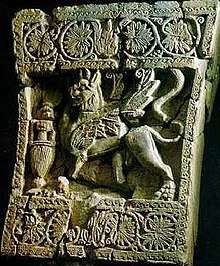
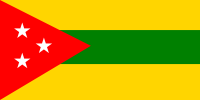
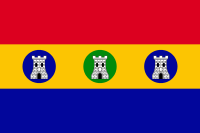
.jpg)


